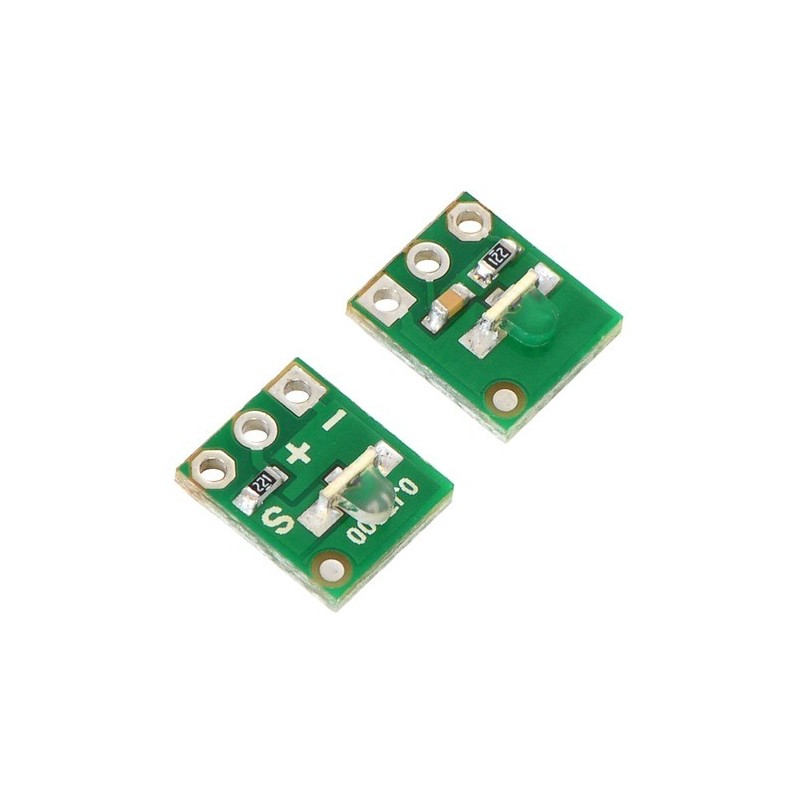

The QTR-L-1RC reflectance sensor incorporates a right-angle infrared LED and a right-angle phototransistor in an inexpensive, tiny 0.35" A— 0.3" module that can be mounted almost anywhere and is great for edge detection and line following. The output is designed to be measured by a digital I/O line. This sensor is sold in packs of two units.
Note: The QTR-L-1RC reflectance sensor requires a digital I/O line to take readings. The similar QTR-L-1A reflectance sensor is available with an analog output.
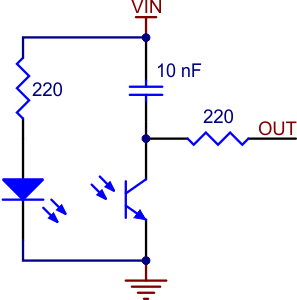 |
The Pololu QTR-L-1RC reflectance sensor carries a right-angle infrared LED and a right-angle phototransistor, both pointing toward the front edge of the board. The phototransistor uses a capacitor discharge circuit that allows a digital I/O line on a microcontroller to take an analog reading of reflected IR by measuring the discharge time of the capacitor. Shorter capacitor discharge time is an indication of greater reflection.
The LED current-limiting resistor is set to deliver approximately 17 mA to the LED when VIN is 5 V. The current requirement can be met by some microcontroller I/O lines, allowing the sensor to be powered up and down through an I/O line to conserve power.
This sensor was designed to be used with the board perpendicular to the surface being sensed, and narrow-angle lenses built into the infrared LED and phototransistor packages allow it to be effective to a range of about 1" (25 mm). Because of its small size, multiple units can easily be arranged to fit various applications such as line sensing and proximity/edge detection. The QTR-L-1RC is sold in packs of two units.
For a similar sensor that can be used with the board parallel to the surface, but with shorter range, please see the QTR-1RC reflectance sensor. We also offer arrays of three and eight sensors: the QTR-3RC reflectance sensor array and the QTR-8RC reflectance sensor array.
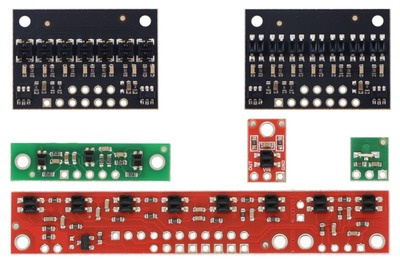 |
| QTR sensor size comparison. Clockwise from top left: QTR-3RC, QTR-1RC, QTR-L-1RC, QTR-8RC. |
|---|
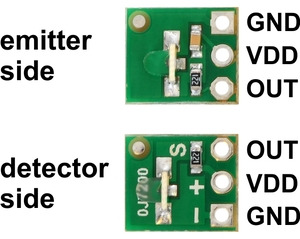 |
Like the Parallax QTI, the QTR-L-1RC module has sensor outputs that require a digital I/O line capable of first charging the output capacitor (by driving the line high) and then measuring the time for the capacitor to discharge through the phototransistor. This measurement approach has several advantages, especially when multiple units are used:
The typical sequence for reading a sensor is:
These steps can typically be executed in parallel on multiple I/O lines.
With a strong reflectance, the discharge time can be as low as several dozen microseconds; with no reflectance, the discharge time can be up to a few milliseconds. The exact time of the discharge depends on your microcontroller’s I/O line characteristics. Meaningful results can be available within 1 ms in typical cases (i.e. when not trying to measure subtle differences in low-reflectance scenarios), allowing up to 1 kHz sampling. The following table shows some typical discharge times (from 5 V down to a 2 V threshold) of the sensor over different surfaces and at different distances:
| White surface | 3/4" black electrical tape | |
|---|---|---|
| 0.25" distance | 100 ÎLs | 320 ÎLs |
| 1" distance | 160 ÎLs | 260 ÎLs |
Ambient light, especially sunlight, can affect the sensor readings significantly. If the discharge time of the QTR-L-1RC is consistently low, you might need to add shielding around the sensor or mount it in a different location to reduce interference from outside light sources.
Our Pololu AVR library provides functions that make it easy to use these sensors with our Orangutan robot controllers; please see the QTR Reflectance Sensors section of our library command reference for more information. We also have a Arduino library for these sensors.
Each pack of two reflectance sensors includes sets of straight male header strips and right-angle male header strips, which allow you to mount them in the orientation of your choice. You can also solder wires, such as ribbon cable, directly to the pads for the most compact installation.
|
|
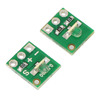 |
QTR-L-1A Reflectance Sensor (2-Pack) |
 |
QTR-1RC Reflectance Sensor |
 |
Female Crimp Pins for 0.1" Housings 100-Pack |
Osoba odpowiedzialna BTC Korporacja sp. z o. o. Lwowska 5 05-120 Legionowo Polska sprzedaz@kamami.pl 22 767 36 20
Moduł czujnika koloru oparty o układ TCS3200 - programowalny konwerter natężenia światła na częstotliwość sygnału elektrycznego. Potrafi filtrować dane RGB ze źródła i przetwarzać na sygnał prostokątny (50% wypełnienia) o częstotliwości zależnej od natężenia światła (irradjancji). Użytkownik może obliczać kolor światła wykorzystując odczytane dane RGB. modColorSensor
Brak towaru
Moduł z czujnikiem promieniowania ultrafioletowego (UV) oparty na układzie GUVA-S12D. Umożliwia pomiar promieniowania o długości fali w zakresie od 240 do 370 nm. Moduł posiada złącze zgodne z standardem Grove. Seeed Studio 101020043
Brak towaru
Czujnik światła otoczenia umieszczony w przezroczystej półkuli oraz wodoodpornej obudowie. Obsługuje zakres detekcji od 0 do 65535 lx i komunikuje się przez interfejs I2C. DFRobot SEN0562
Czujnik do wykrywania odległości, natężenia i częstotliwości błyskawic w promieniu 40 km. Moduł umożliwia entuzjastom pogodowym mierzenie danych o lokalnych burzach. SparkFun SEN-15441
Brak towaru
Moduł XH-M131 pozwala na sterowanie urządzeniami o poborze prądu do 10A w zależności od natężenia światła, co czyni go idealnym jako czujnik zmierzchowy do oświetlenia domu czy garażu. Jest łatwy w obsłudze dzięki regulacji poziomu światła potencjometrem, jest zasilany napięciem 12 V i nie wymaga lutowania, co ułatwia instalację. XH-M131
Moduł z optycznymi czujnikami inspekcyjnymi (spektrofotometrami) z serii AS7265x. Składa się z trzech czujników; AS72651, AS72652 i AS72653, które mogą wykrywać długości fali od 410nm (UV) do 940nm (IR). SparkFun SEN-15050
SparkFun Spectral Sensor AS7263 NIR to moduł z czujnikiem spektrum, który działa w zakresie światła widzialnego oraz poniżej zakresu widzialnego - bliskiej podczerwieni (NIR). Czujnik ten pozwala zmierzyć i scharakteryzować jak badana powierzchnia pochłania lub odbija światło. Moduł pozwala na pomiar fali świetlnej o długości: 610nm, 680nm, 730nm, 760nm, 810nm oraz 860nm. SparkFun SEN-14351
Brak towaru
KAmodVL6180X to moduł pozwalający na pomiar natężenia oświetlenia (ALS), odległości od obiektu oraz rozpoznawanie gestów. Ma wbudowany stabilizator napięcia oraz translatory poziomów logicznych, dzięki czemu może być wykorzystany w systemach zasilanych napięciem 2,8V - 5,5V
Czujnik natężenia światła oparty na układzie VEML7700. Posiada duży zakres pomiarowy (0-120Klx). Do komunikacji z modułem służy interfejs I2C. Moduł posiada złącza zgodne z standardem Gravity. DFRobot SEN0228
Czujnik do wykrywania odległości, natężenia i częstotliwości światła (błyskawic) w promieniu 40 km. Moduł umożliwia entuzjastom pogodowym mierzenie danych o lokalnych burzach. DFRobot SEN0290
Bezprzewodowy czujnik z komunikacją w ramach sieci LoRaWAN. Dedykowany do przemysłowego pozyskiwania danych na duże odległości z szerokim zakresem pomiarowym natężenia światła od 0 do 160000 Lux. Seeed Studio 114992868
Moduł z czujnikiem światła otoczenia VEML6030 o zakresie pomiarowym do 120 000 lx. Umożliwia pomiar światła z 16-bitową rozdzielczością. Komunikacja I2C. SparkFun SEN-15436
Moduł z cyfrowym czujnikiem natężenia światła MAX44009. Zasilany jest napięciem od 1,7 do 3,6 V i komunikuje się przez interfejs I2C. GY-49
Moduł z czujnikiem światła - fototranzystorem LS06-S . Płytka została wyposażona w złącze Grove i ma wyjście analogowe. Seeed Studio 101020173
Moduł z czujnikiem natężenia światła LTR-303. Oferuje zakres pomiarowy od 1 do 65535 lux i 16-bitową rozdzielczość. Komunikacja odbywa się przy użyciu I2C. Adafruit 5610
Moduł z czujnikiem płomienia wykrywa źródło emitujące falę o długości od 760 do 1100 nm. Pozwala wykrywać m.in. źródło ognia. Interfejs analogowy. DFRobot DFR0076
Brak towaru

